#modern weimar
Text
Neues Bauhaus Museum Weimar - 2. Preis ex aeqou
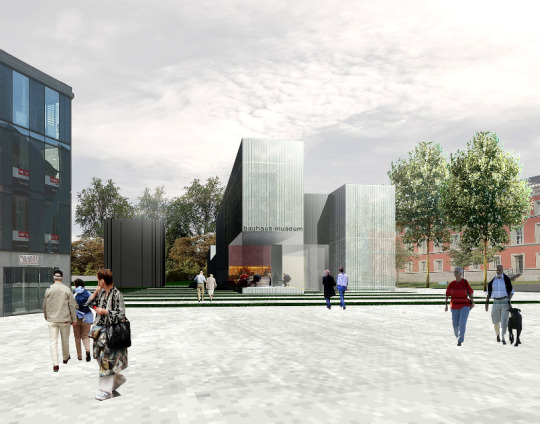
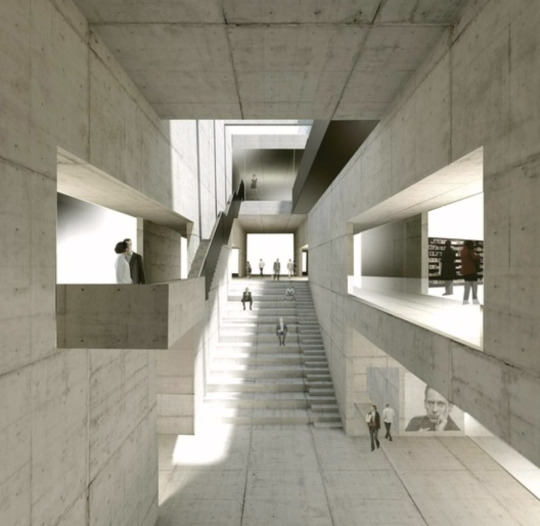
Internationaler Wettbewerb mit 536 Teilnehmern, 2012
2. Preis ex aequo (1. Preis wurde nicht vergeben)
Entwurf: Klaus E. Krauss, Berlin
mit Rolf Kursawe, Köln und
Dipl.-Ing. Rolf Teloh (urban essences, Berlin), Dipl.-Ing. Anette Hartung ( Lichtplanung Hartung, Köln), Dipl.-Ing. Johannes Römer (Thor Bauphysik, Bergisch Gladbach), Dipl.-Ing. Frank Luckau (Luces Ingenieure, Pulheim), Dipl.-Ing. Kim Leiermann (KL Brandschutz), Studentischer Mitarbeiter Christian Wabbel
Weimar besitzt eine einzigartige Sammlung zur Vorgeschichte, der Geschichte und Nachwirkung des Staatlichen Bauhauses, das hier 1919 gegründet wurde. 1995 konnte ein provisorisches Bauhaus-Museum in dem von Clemens Wenzeslaus Coudray errichteten Gebäude am Theaterplatz eingerichtet werden.
Der Wettbewerb dient dazu, für das neue Bauhaus-Museum und für das städtebauliche Entwicklungspotential des Standorts die beste Lösung zu erhalten. Der Neubau des Bauhaus-Museums Weimar ist Teil des Masterplans ›Kosmos Weimar‹ der Klassik Stiftung Weimar.
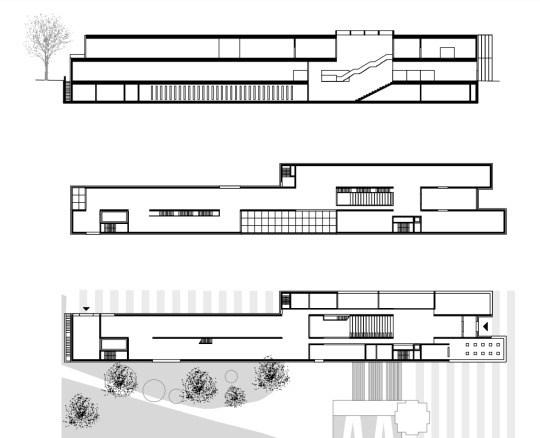
“Der Entwurf … schafft einen gelungenen Zugang zum Park. Die markante Museumsgestalt wirkt stärker in den Stadtraum und wird durch die geschickte Staffelung lang gestreckter Baukörper bestimmt. Mehr noch lebt der Entwurf von den Qualitäten des Innenraums. Der zentrale Innenraum bildet ein differenziertes, eigenständiges und attraktives Angebot für das Neue Bauhaus-Museum.”
(Auszug aus dem Juryprotokoll)
Beim VOF-Verfahren erhielten die Drittplatzierten des Wettbewerbs Frau Prof. Heike Hanada und Prof. Benedict Tonon den Zuschlag zur Ausführung ihres Entwurfs.




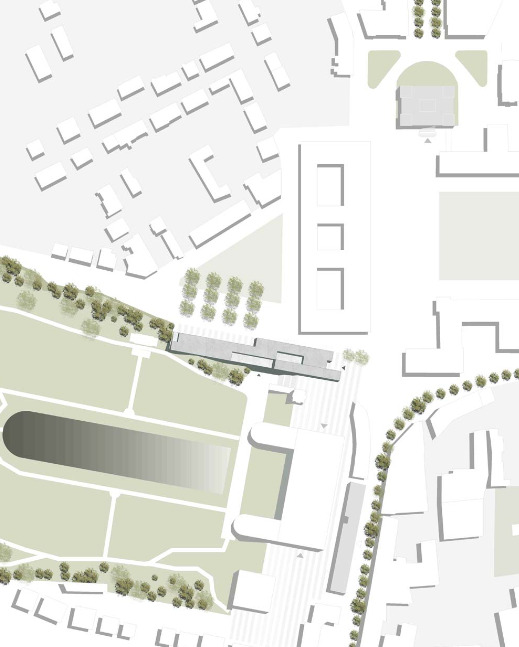

#bauhausmuseumweimar#modern weimar#weimar#bauhausmuseum#bauhausarchiv#bauhaus#urbanism#city planning#architecture#modern architecture#competition#competitionline#wettbewerbeaktuell#architecture hunter#competitionlineranking#archdaily#dailyarchitecture#urban planning#new museum#museum#art museum#museum aesthetic#art history#culture#walter gropius#modernarchitecture#klaus e. krauss#bauhaus-movement
7 notes
·
View notes
Text
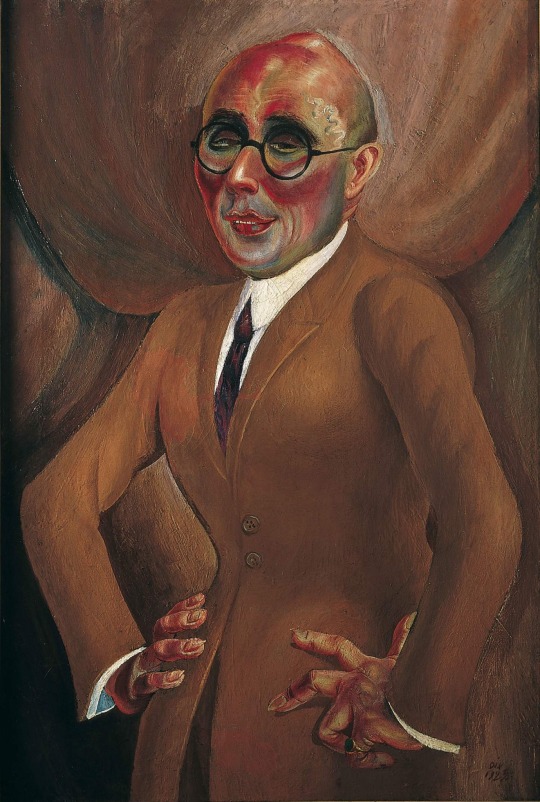
Otto Dix, Portrait of the Jeweller Karl Krall, 1923
#otto dix#german painting#german art#german painter#german artist#weimar#portrait#portrait painting#portrait art#portraiture#modern art#art history#aesthetictumblr#tumblraesthetic#tumblrpic#tumblrpictures#tumblr art#aesthetic#beauty
105 notes
·
View notes
Text
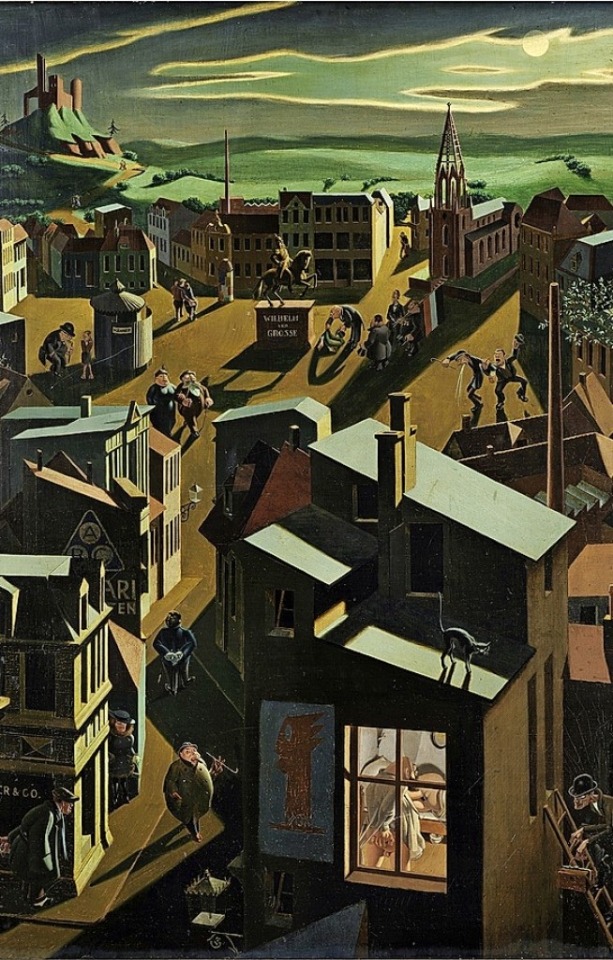
Georg Scholz, Deutsche Kleinstadt bei Nacht, 1923
#Georg Scholz#new objectivity#neue sachlichkeit#weimar republic#modern art#1920s berlin#weimar berlin#1920s painting#magic realism#modernism#babylon berlin#voyerurism#spooky#German village#1920s Germany
177 notes
·
View notes
Text





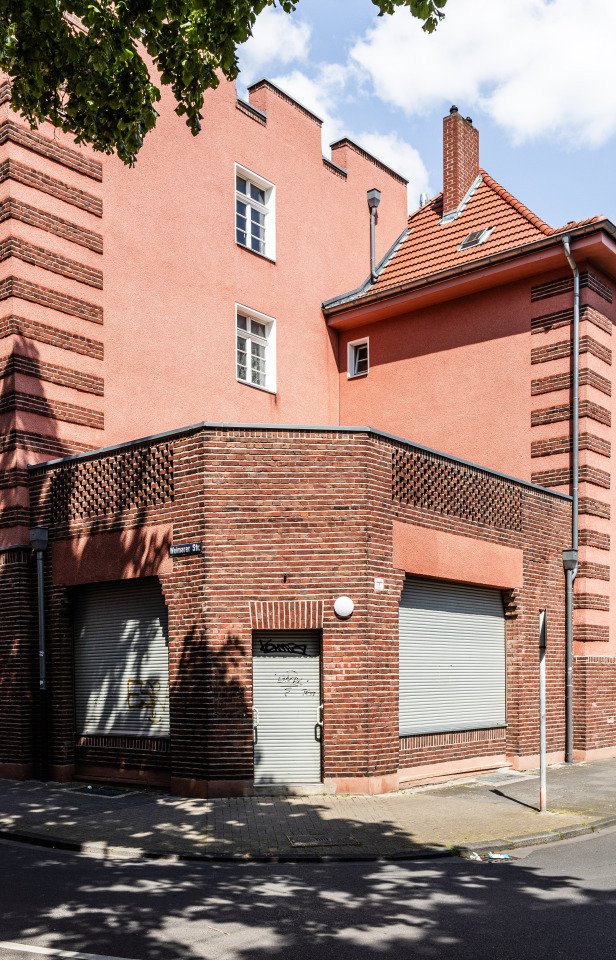
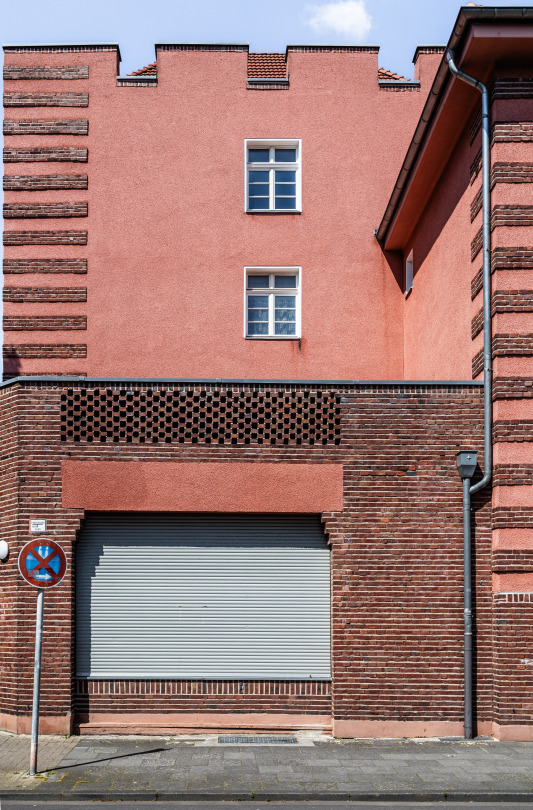

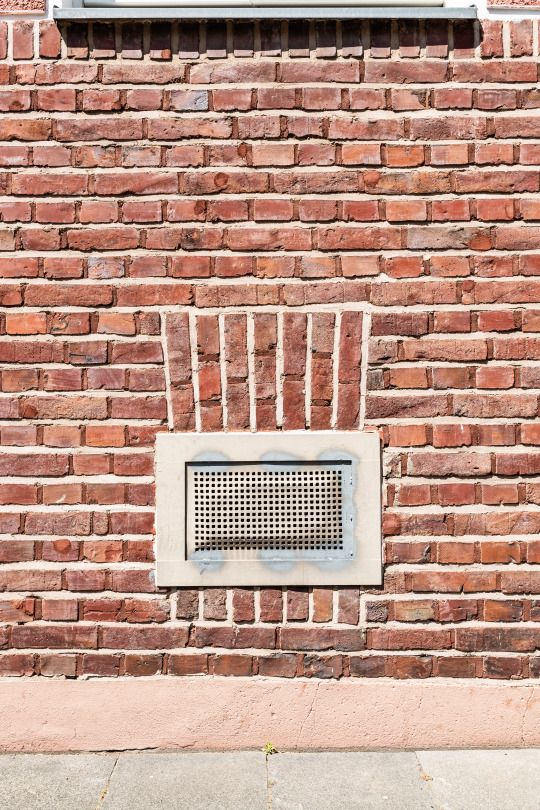










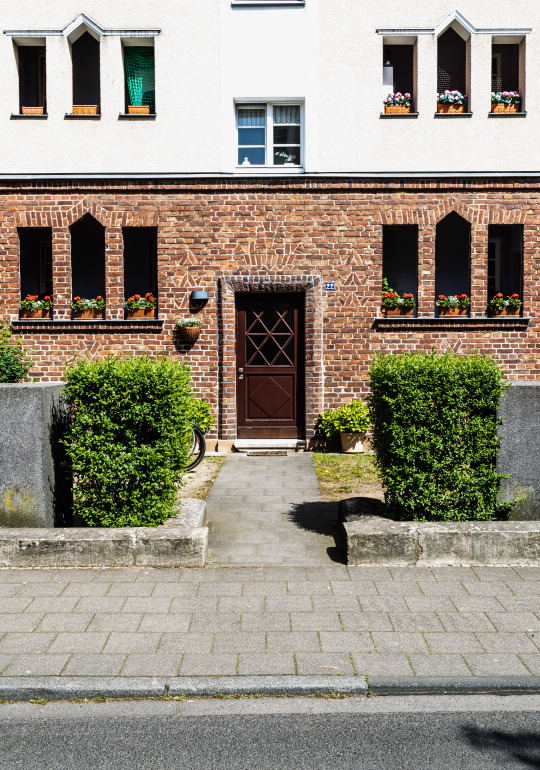

germaniasiedlung // köln höhenberg
architects: a total of 18 different
construction time: 1919-1929
the germaniasiedlung in cologne höhenberg is an ideal place to familiarise yourself with the entire range of architectural styles of the weimar republic. this is due to the long construction period and the large number of architects involved.
the diversity is also one of the reasons why the estate is almost completely listed. it has also been extensively renovated and modernised in recent years. the gag also operates a museum flat where you can experience what the original furnishings looked like.
die germaniasiedlung in köln höhenberg bietet sich an um die komplette bandbereite an architekturstilen der weimarer republik kennenzulernen. dies ist bedingt durch die lange bauzeit und die vielzahl der architekten die daran beteiligt waren.
die vielfältigkeit ist auch einer der gründe warum die siedlung nahezu komplett unter denkmalschutz steht. in den vergangenen jahren wurde sie zudem auch umfassend renoviert und modernisiert. die gag als besitzerin der siedlung betreibt auch eine museumswohnung in der man auch erleben kann wie die ursprüngliche ausstattung aussah.
für einen besuch sollte man allerdings zeit mitbringen allein aufgrund der größe der siedlung. es gibt aber mit büdchen und kneipe auch orte zum erfrischen und ausruhen.
#cologne#köln#photography#architecture#architecture photography#rhineland#weimar republic#design#brick#brick architecture#neues bauen#germany#nrwe#neue sachlichkeit#moderne#neues bauen im rheinland#neues bauen im westen#modern brick architecture#brick design#siedlungsbau weimarer republik#köln höhenberg#expressionism#expressionist architecture
52 notes
·
View notes
Text
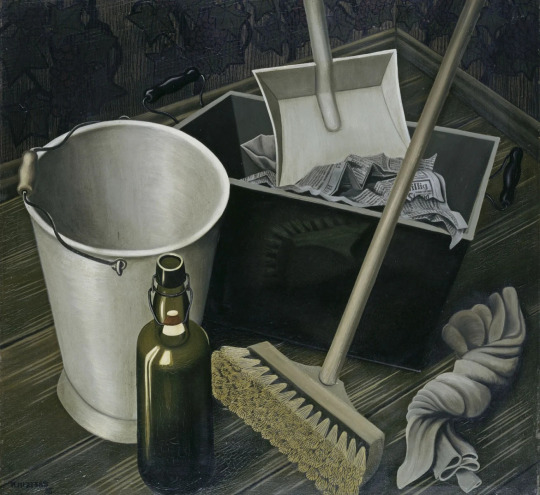
Hans Mertens (German, 1906-1944) • Still Life with Household Appliances (Stilleben mit Hausgeräten) • 1928 • Sprengle Museum, Hanover, Germany
#hans mertens#german artist#art#fine art#art history#art of the still life blog#still life#german avant-garde#european avant-garde#modern art#modernism#weimar republic#artist#artwork#art blog
25 notes
·
View notes
Text

Porträt von Speedy Schlichter (b. Elfriede Elisabeth Koehler), 1929. © Deutsche Kinemathek – Hans G. Casparius | src Deutsche Kinemathek
view & read more on wordPress
100 years of Weimar Republic, 100 years of modern cinema – we look back at the relationship between cinema and everyday culture, the innovations of the film trade and the emergence of film criticism and theory in the 1920s.
Like no other art form, cinema reflected the spirit of the modern era: fashion and sports, mobility and urban life, gender issues and the emergence of psychoanalysis characterize the films of the period, which would have a profound influence on read more
#Speedy Schlichter#weimar republic#deutsche kinemathek#Hans Casparius#Elfriede Elisabeth Koehler#german actress#german cinema#kino der moderne#portrait#Porträt#retrato#1920s#ritratto#portret#retrat#Bildnis#veiled women#veiled woman#weimar republic art#weimarer republik
72 notes
·
View notes
Text

More details
A group of figures in front of a window, formed by dance students at Laban's Choreographic Institute in Berlin-Grunewald (November 1929).

More details
Young people performing a rhythmic dance at Laban's Choreographic Institute in Berlin-Grunewald (1929).

Rudolf von Laban in the midst of his students (ca. 1929).

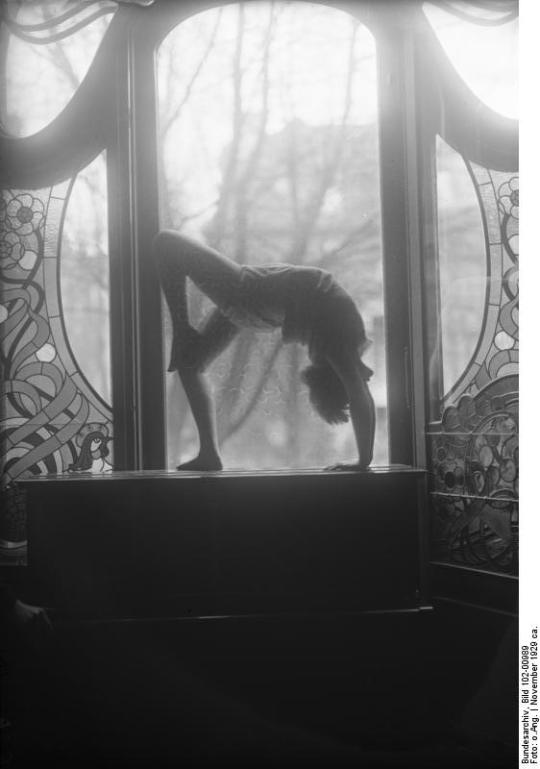
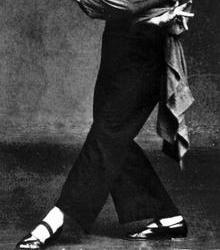
Rudolf von Laban

An art-nouveau window, just because. All other images from Rudolf von Laban's Tanzschule Laban.
5 notes
·
View notes
Text
no but trying to give gil a label that isn't just "he's a dyke :D", uhhhh
'will kill you if you she/her him' to 'all pronouns queer', this works in different timelines/universes but i'm thinking both in the same timeline just depends of when and where.
#half joking... as usual i will use whatever is the best for a story#instead of exact hcs#but if not modern i usually land in: character(s) won't think about that#or thought about that in old terms and then going back to zero (*coughs* weimar)#or not too zero... 'repress that shit'#should i be doing something else? absolutely- bye
3 notes
·
View notes
Text

'Berlin Babalon (E.P)' now available to pre-order!!
#bandcamp#bandcampmusic#berlin#cabaret#anita berber#weimar#decadence#1920s fashion#1920s#1920s music#modernism#new music#post rock#vampires#vampcore
3 notes
·
View notes
Text
Haus der Weimarer Republik, Theaterplatz Weimar


Internationaler Wettbewerb 2017
Entwurf: Klaus E. Krauss, Berlin und Rolf Kursawe, HKR+ Architekten, Köln
Städtebau
Der Entwurf orientiert sich am Workshop-Ergebnis von 2015.
Ausgehend von der damaligen Variante „Wohnen“ halten wir
hofartige Bebauungen östlich des ehemaligen Zeughauses für ein
adäquate Antwort auf die vorhandenen Umgebungsstrukturen.
Jedoch halten wir es für notwendig, die neuen Baukörper weniger
schematisch sondern eher individuell auf die vorhandenen
erhaltenen Einzelbauwerke reagieren zu lassen.
Wir sehen es als unabdingbar, statt der „aufgelösten“ Struktur des
Workshop-Ergebnisses eher die Struktur der Altstadt weiterzubauen
und raumbildende Baukörper vorzusehen; nur so lässt sich die hohe
Qualität des öffentlichen Raumes in der Altstadt auch an dieser
Stelle we

iterführen.
Architektur
Die Öffnung des derzeit bestehenden Eingangs zu einer
„arkadenartigen“ Loggia ermöglicht einen spannenden
Gegenpart zum Nationaltheater und dem Denkmal von
Schiller und Goethe, aber auch einen angemessenen Zugang
zum Haus der Weimarer Republik.
Das neu entstehende Foyer verzahnt als lichtdurchfluteter
Raum die unterschiedlichen Ebenen von Ausstellungsräumen
und Multifunktionsraum mit Garderobe und Nebenräumen;
gleichzeitig entsteht ein lebendiger Bereich für alle Besucher.
Die noch vorhandenen Außenmauern des Zeughauses
werden bewusst als eigene Zeitschicht erhalten und
umrahmen einen „eingestellten“ verglasten Neubau, der so
auch alle schwierigen Anschlusspunkte zwischen Alt und Neu
konsequent vermeidet.
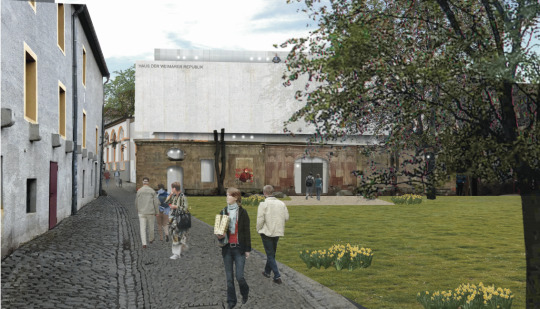




#modern architecture#architecture#urbanism#architektur#building#architettura#klaus e. krauss#modern weimar#weimar#weimarer republik#haus der weimarer republik
3 notes
·
View notes
Photo

Ernst Neuschul, Messias, 1919. Oil on canvas, 94 x 53 cm
#messias#Ernst Neuschul#1919#Weimar Republic#neue sachlichkeit#new objectivity#selbstbildnis#self-portrait#magic realism#post expressionism#world war one#Babylon Berlin#painting#interwar art#modern art#realism
249 notes
·
View notes
Photo
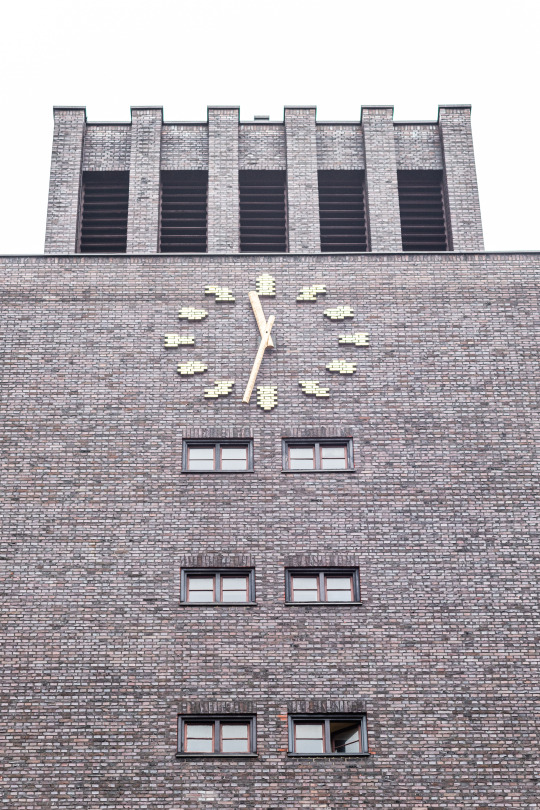




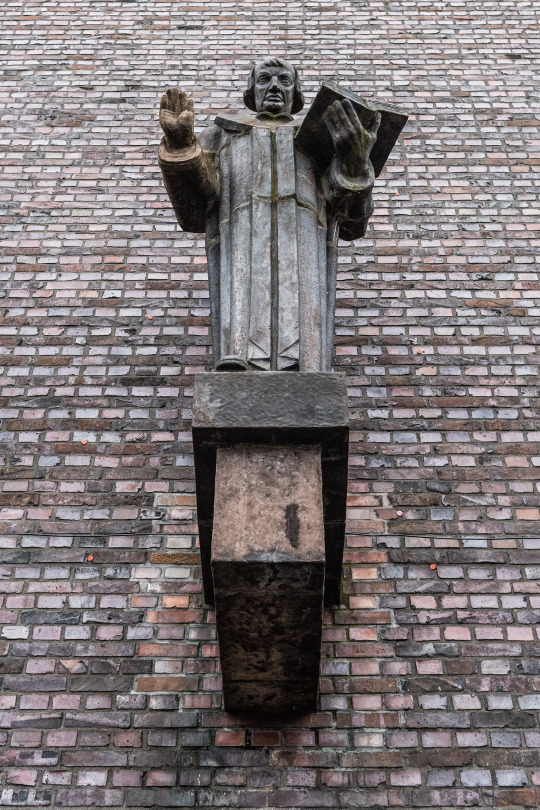

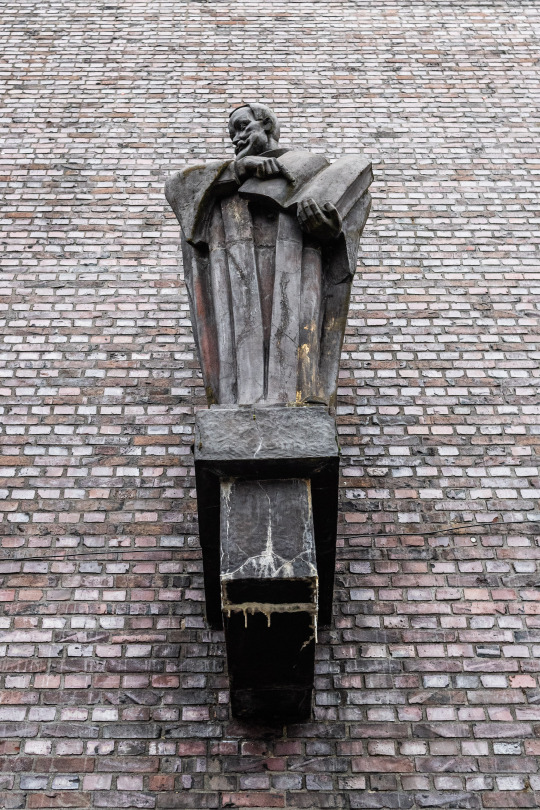

bugenhagenkirche // barmbek süd
the mighty structure of the church made of clinker brick with its cubic shape, which ends in the enormous tower, dominates the street front. the only sculptural decoration are the larger-than-life ceramic figures of hamburg's reformers.
in front of the building, one simply feels tiny and humble. i can imagine that this was also the intention of the builders, to show how small man is before god.
architect: emil heyen
completion: 1929
art in architecture by alphons ely, richard kuöhl & friedrich wield
#expressionism#neues bauen#neue sachlichkeit#new objectivity#weimar republic#barmbek süd#hamburg#hamburg barmbek#architecture#photography#architecture photography#urban#urban photography#design#modern church architecture#modern church design#bugenhagenkirche hamburg#klinker#modern brick architecture#brick#germany#emil heyen#alphons ely#richard kuöhl#friedrich wield
286 notes
·
View notes
Text
Book I just finished strikes perhaps the strangest compromise I've seen yet between speculative fiction should imagine worlds without real world opression vs speculative fiction shouldn't shy away from real world oppression, which is "what if sexism and homophobia were invented for the first time in the 1920s by the fantasy nazis"
#the book is amberlough#and the setting is a very on the nose analog of weimar berlin#but also there seems to be greater gender equality than our modern world in a lot of ways & everyone is assumed bi by default#but also the fantasy nazis have a Return To Traditional Gender/Sexual Roles platform#despite? not seeming to have any actual traditions to return to?#'women should stay in the home' & 'the homosexuals (which this setting doesnt have a term for) should stop living in sin'#seem to be fully novel concepts in this world?
11 notes
·
View notes
Note
not to be weird..............but what preferences of jameson do you have in mind 👁️👄👁️
ok so. opposite of yours. hes aro and gay and likes keeping pretty boys around. and likes telling them what to do. and likes dressing them up. and likes keeping cheeky little polaroids of them in his wallet. and likes dating smug people just to knock them down a notch. and likes telling them no. and likes tying knots. and likes catching people off guard so they cannot tell if he's being flirty or not because he's so innocent and polite. and likes watching them obey. and likes taking care of them. and likes dragging everything out like a slowburn to drive them crazy. and likes being very sweet about it. and likes pulling on their ties or shirt to kiss them because he's short and doesn't always wanna go on his tiptoes. and likes a good show
#i was going to put a screenshot of the time june was like ''doesnt your james have a daddy kink'' bc its one of the funnier messages that#ive gotten in my life. but the answer is generally no so i will not#anyway i am. as i have mentioned before. Scared so i know this is vague as hell hornyposting but i think it gives the general idea#definitely went to the risque cabarets in the indulgent days of weimar germany before he got yanked into the modern day#u meet this dude at a fancy event he was invited to with marvin and hes like ''im a tailor and i must say i love your little ensemble :)''#and the next thing u know hes got u in smeared lipstick and at his mercy#semi nsft#my ego posts#my ego hcs#he can be corrupted tho bc its fun. none of the other egos have managed it yet
8 notes
·
View notes
Text
It’s been several weeks since I started watching Nosferatu, and I finally picked it up last night since I now have a knitting project suitably mindless that I can do without having to look at it and can watch the movie in peace. I’ve finished the third act, and I have to say, this is honestly really faithful to Dracula. Since it’s never been a secret that Nosferatu is heavily inspired by Dracula (read: an unauthorized adaption), I’m going to assign Dracula names to the roles characters play in the story rather than use their actual names most of the time.
The character combinations are interesting, but make a lot of sense given the large cast of characters in the book. I haven’t gotten far enough for most of the secondary characters to be a major presence, but I’ve read that they’re mostly absent, so the focus remains mostly on the Jonathan and Mina figures.
One of the biggest changes so far is that Mr. Hawkins and Renfield are combined into Knock, a now-malicious solicitor secretly in kahoots with the Count.
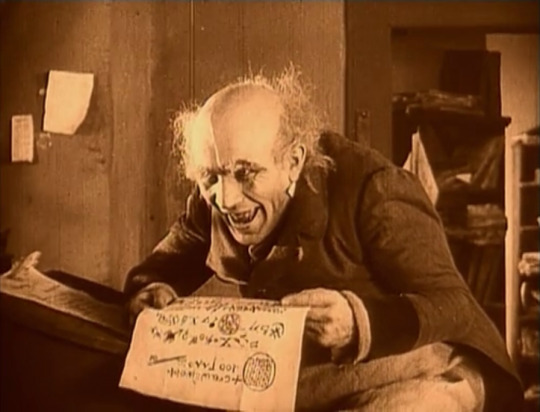
Narratively speaking, this actually makes a more of sense than it might sound at first. Mr. Hawkins is mostly a plot device in the original story, not really a character, and given the restraints of a silent film, it would be rather challenging to establish why and how the Count wants to visit England. When you strip down the conversations from the captivity portion of the novel, you’re left with the challenge of how to convey the Count’s desire or to establish how exactly he made arrangements with a foreign solicitor, so giving him an agent abroad is a pretty economical way to convey that. Then, when the Count is travelling, using Knock as a Renfield-figure and thrall of the Count serves to heighten the tension, and while the “the life is in the blood” speeches are a little less mysterious, they do pair very well with the back-and-forth between the not-Demeter and not-Van Helsing teaching a botany class about carnivorous plants.
The major downside of that choice is that it removes much of the nuance present in the books regarding the characters under the Count’s sway. Renfield and Seward’s back and forth about the nature of sanity is so far completely absent, and I expect this will be the case through the movie, going off of the visual language’s cartoonishly malicious depiction of Knock. Renfield’s humanity is really just not shown, and while Knock’s gleeful manner while eating bugs is quite similar to Renfield’s manner in the book, I highly doubt the element of resistance will show up.
Still, overall, this feels like a simplification rather than a warping of the story. Unfortunately, it’s a simplification that results in a caricature of mental illness, and yet I don’t think it’s a fundamental misreading of the story, unlike Drac/Mina pairings.
The second major change so far is that Mina and Lucy’s role have been combined into one, and given their similar narrative roles as vulnerable and beloved targets, this makes a lot of sense. Now, the Mina-figure is the sleepwalker. There is a slight change in that the prophetic dreams start earlier, but it also serves to emphasize her connection with Jonathan without the letter and journal devices. It also establishes her vulnerability early on, pretty much as soon as we realize that Jonathan is in peril, which is an effective way to convey the peril of Lucy-Mina without diary entries and serves to jump-start the middle act of the story (which I admittedly found rather slow during Dracula Daily)
In a related vein, there’s another convenience change that’s either big or small depending on what you view as an important theme. In Dracula, the Count seems primarily interested in England, and his later vendetta is the result of his predatory nature, not the driving motivation. In Nosferatu, that’s flipped, and his primary motivation to leave his castle is to track down not-Mina. He presumably did first send for a solicitor, though, so the motivation isn’t absent, it’s just less developed.
Apart from character changes, the biggest other change is that the Count spreads plague rather than just killing or turning characters. So far, it doesn’t feel fundamentally different from the book, but I don’t know yet if it will have larger plot implications down the line.
I will say, though, that the time period is always waiting a little bit uncomfortably at the back of my mind. It came out in 1922, and there’s just so much going on in the Weimar Republic at this time. It’s a culturally wild time. I don’t know a lot about this film, or its make, or how it was received, so I’m just left with vague implications about the various changes and how they would be received. What does it suggest that he spreads a plague? What does his increased focus on preying on Mina mean? What are the implications of the fact that he has an apparently willing agent abroad, or that Renfield is only a slavish caricature, totally devoted to the count?
I don’t know the answers to these questions, but they’re always looming somewhere as I watch.
#dracula daily#nosferatu#i initially was confused by why he was travelling by boat before realizing i'm conflating germany and the weimar republic#and forgetting about different territorial boundaries#then i also wondered whether or not the plague device diminished the effectiveness of the captain's sacrifice—why was he tying himself up?#i think i would not understand why he's doing it if i wasn't already familiar with dracula#still though i really loved those scenes#which i guess makes sense. the demeter passages were one of my favorite parts of Dracula Daily#however i will say that watching the captain and mate throw the corpse of their crewmate overboard was visually effective#in a way that i think the fearful journal entries would not have been able to translate directly to film#and i think one of the most impactful changes made by the chronological format (she says having only read it that way)#because for me the slow terrifying countdown was one of the most ominous parts of the book#because i was both concerned for the crew of the demeter but also worried about the main characters#if they survive and make it that's terrible; if they don't it's a tragedy#and since as a modern reader i already kind of know that dracula is a vampire and bad news#i don't think that the unravelling the mystery of the abandoned ship would have led to any real dread#i may not have known much about Dracula but as a modern reader i do know that the count's a vampire and that means bad news#(okay more accurate to say until her dream)#I have to say: epistolary to silent film might be one of the widest gulfs to jump (with maybe only ballet being further?)#because your ability to use words is very limited and an epistolary is all about the words#the thing they do have in common is the need to distill things down to their essence#because the conceit of the epistolary requires you to at least believe the characters are recounting what happened#so you can't get TOO detailed or verbose without an explanation for how their memory is so good or they don't get fatigued#and when they recount things they're really summarizing what happened. so they have to pick what matters most#and with a silent film you're trying to convey emotions without verbal/speaking people's primary form of communication#so body language is exaggerated and you are very limited in how much you can use words#and have to boil things down to their essentials
12 notes
·
View notes
Photo
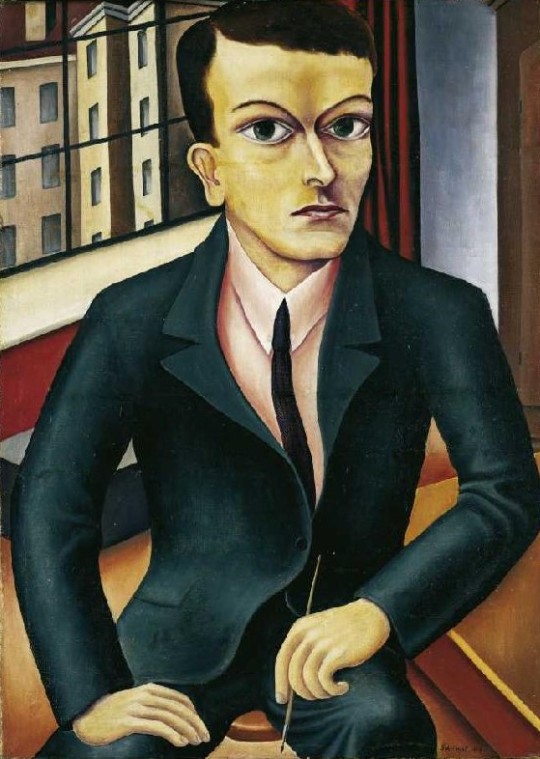
Georg Schrimpf, Selbstbildnis, c. 1918.
#georg schrimpf#neue sachlichkeit#magic realism#Weimar Republic#munich artist#selbstbildnis#self-portrait#modern art#1918#november revolution
7 notes
·
View notes